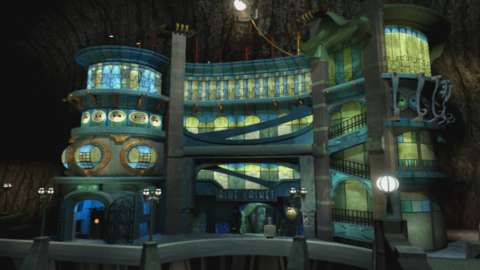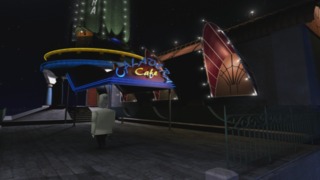In video games, some trends go out of style, and old stand-bys are cast aside when better alternatives are discovered. Some elements of art are timeless, however. Language and culture may change, but empathetic characters and great stories never fade from fashion. Grim Fandango has always stood tall as one of the PC adventure greats, and the deft storytelling and warm humor that made it so inviting remain evergreen.
You can thank Manny Calavera for that warmth, which may come as a surprise given that he’s cold and buried. Manny is a travel agent in the land of the dead, where he suffers the arrogance of a cocksure co-worker and the disrespectful gaze of a corrupt boss. They’re all skeletons--most dead people are, of course--but they’re more human than most video game characters. As Manny flees his job in pursuit of the beautiful and skinless client who has captured his heart, he surrounds himself with an eclectic array of kooks, including the obese and naive Glottis, a demon mechanic prone to betting on cat races. “The doctors made me promise I wouldn't do it any more,” he says, when Manny confronts him. “But they can’t get in the high roller’s lounge, now can they?”

Glottis is Manny’s closest friend, but there’s room in his life for other demons--and more than a few souls who have wandered off the four-year path to the ninth underworld. This is Mictlan, the afterlife through the eyes of the Aztecs, who envisioned that path as being filled with deadly obstacles like winds made of razor-sharp blades. Manny encounters obstacles (this is a puzzle-adventure, after all), but few are quite as deadly as knife-wind, though there are dangerous flaming beavers to contend with. In its illustrations, the holy Codex Borgia depicts Mictlan as teeming with surreal wildlife and grotesque deities; Grim Fandango looks to Mexican celebration Dia de Muertos for its primary artistic inspiration, however. It’s as if Manny and his skeletal friends have leapt from a José Guadalupe Posada drawing, or perhaps just escaped a particularly joyous Day of the Dead celebration.
You needn’t know about Grim Fandango’s cultural significance to grow attached to its characters. Every situation is steeped in humor, but the chuckles rarely come at anyone’s expense. The game is both funny and gentle: even the most mercurial residents of this world are allowed their dignity, and the adventure is better for it. Glottis may be good for some lighthearted comedy, but he’s not the butt of the joke; when he tells Manny, “I don't want to be a pianist any more. I'm a mechanic,” it’s hard not to be moved. It’s a fitting tone, considering how Dia de Muertos invites us to celebrate those that have passed by remembering how they made us laugh. Manny’s surname itself refers both to actual skulls as well as to humorous poems that honor the dead, which makes a scene in which he attempts a bit of beat poetry particularly wonderful. (“My teeth... Everythingness. Or is it? I am your failure. Ske-bee bop, bop! Ske-bee bop, bop! Woman? The phone is for you.”)


But what about the play? Returning to an old game can make you appreciate advancements that have since come. Playing Grim Fandango Remastered, however, might make you wonder why point-and-click adventures didn’t more frequently crib from its pages. You do not swipe a cursor around, hunting for interactive objects. Instead, you steer Manny directly using either the original's tank controls or an updated scheme in which Manny moves in the direction you push, and his bony head turns to look at the people he can speak with and the things he can collect as you pass them. (The PC version of the remaster comes with a point-and-click scheme, but Grim Fandango is at its most personal when you use direct controls.) It’s a lovely solution to a genre-wide design issue, yet so uncommon that it feels utterly fresh. The game’s inventory management is equally brilliant: Manny reaches into his suit jacket and cycles through each item one at a time. There is no laborious item combining within the inventory screen, and developer Double Fine never allows Manny’s jacket to become overstuffed with doodads.
That means that the focus can remain on the puzzles themselves, almost all of which make absolute sense within this world. It may sound silly, but in context, it makes absolute sense that you would scare away pigeons by fooling them into pecking an inflated balloon animal. If you get stuck, it’s not because you aren’t following a ridiculous line of logic that no reasonably smart person could guess. No--chances are you haven’t explored thoroughly enough, or Double Fine actually managed to fool you with a red herring, such as one involving a loaf of ceremonial bread and an old-fashioned pneumatic tube.
That isn’t to say Grim Fandango doesn’t harbor its minor annoyances. It’s easy, for instance, to walk into that elevator in Rubacava by accident when you wander too close and descend to ground level, only to have to get back in and rise again to the top. More relevant is the remastering itself, which might leave you disappointed in light of the dramatic visual transformations we see in remakes like Oddworld: New ‘n’ Tasty!, or remasters like Halo: Combat Evolved Anniversary. You can see the differences between the old version and the remaster with a click of a button, and you’ll note that environments and cutscenes haven’t changed in any meaningful way. Granted, Grim Fandango’s background art remains vibrant, but the new, smooth character models and shadows sometimes look out of place as a result. I often found myself sticking with the original models just because they looked more natural in front of the low-resolution backgrounds.

There is a significant bright side if you are interested in video game archival, however: developer commentary. It’s an all-too-rare treat, and one that belongs in any remaster, of which there have lately been too many to count. Of course, it helps that Grim Fandango lead developer Tim Schafer is so good-natured when sharing his memories, but the commentary is endlessly entertaining, whether the Double Fine team is cracking jokes about dulce de membrillo (would have thought that a brief story about quince cheese would be so silly and sweet?) or waxing serious about the Red Scare. The director’s commentary is a standard DVD and Blu-Ray feature, which makes the scarcity of video game commentary all the more disheartening, particularly when remasters, remakes, and reimaginings are de rigeur.
Grim Fandango’s greatest triumph, however, is that you needn’t overflow with nostalgia to appreciate its greatness. There is only this boisterous world and the unionized bee-demons that inhabit it, which you see through the eyes of one Manny Calavera, an everyday hero that has rightfully earned a place in video game history. Even if you don’t know what happens at the end of the line, you’re guaranteed to enjoy the trip.